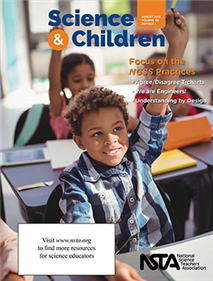Science and Children: an August issue?!!!
By Peggy Ashbrook
Posted on 2018-07-31
 Did you know that there is an August issue of Science and Children? Yes!!!! (fist pump, happy dance, big smile). Getting the next issue in August before planning the first month of school rather than during the first week will help me do what I had planned to do at the end of the school year—reflect on the past year of teaching. I wanted to go over what worked well, how eagerly the children engaged with some explorations, and the times when I messed up by forgetting materials or asking children for too prolonged attention. The fresh material in the August 2018 issue will give me new ideas but also inspire me to prepare for the coming school year using the bones of my previous year of teaching, kind of like a good chicken soup begins with the bones of the chicken we had last night.
Did you know that there is an August issue of Science and Children? Yes!!!! (fist pump, happy dance, big smile). Getting the next issue in August before planning the first month of school rather than during the first week will help me do what I had planned to do at the end of the school year—reflect on the past year of teaching. I wanted to go over what worked well, how eagerly the children engaged with some explorations, and the times when I messed up by forgetting materials or asking children for too prolonged attention. The fresh material in the August 2018 issue will give me new ideas but also inspire me to prepare for the coming school year using the bones of my previous year of teaching, kind of like a good chicken soup begins with the bones of the chicken we had last night.
 Beginning with the Editor’s note, the new Editor, Elizabeth Barrett-Zahn, reaffirms for me why writing, mentoring, and attending conferences makes me a better educator for children and adults: “We can learn from each other, whether down the hallway or across the globe. The journal serves as a way to widen our common collaboration pathways both vertically and horizontally.” This issue is rich in pathways for early childhood educators, including the few I discuss here.
Beginning with the Editor’s note, the new Editor, Elizabeth Barrett-Zahn, reaffirms for me why writing, mentoring, and attending conferences makes me a better educator for children and adults: “We can learn from each other, whether down the hallway or across the globe. The journal serves as a way to widen our common collaboration pathways both vertically and horizontally.” This issue is rich in pathways for early childhood educators, including the few I discuss here.
Will your children be investigating their senses? Do you want to learn more about the 5E model for writing lesson plans? See “Waves Sound Great! First graders explore what makes sound through a 7E learning cycle.”
 In “Using the Understanding By Design Model and NGSS in Concert to Plan and Instruct in Science,” written for educators who teach early elementary grades, we get support for “starting at the end rather than at the beginning of the planning process.” This “Understanding by Design (UBD)” planning process helps educators avoid the struggle of matching an activity to a specific standard because the process begins with knowing where you want your students’ understan
In “Using the Understanding By Design Model and NGSS in Concert to Plan and Instruct in Science,” written for educators who teach early elementary grades, we get support for “starting at the end rather than at the beginning of the planning process.” This “Understanding by Design (UBD)” planning process helps educators avoid the struggle of matching an activity to a specific standard because the process begins with knowing where you want your students’ understan ding of science concepts or knowledge to conclude upon lesson or unit completion.
ding of science concepts or knowledge to conclude upon lesson or unit completion.
“We Are Engineers! Engineering design activities for preschoolers introduce practices and encourage scientific habits of mind” describes a series of building and engineering design projects that can be adapted for older children too.
The “Guest Editorial: Addressing Common Questions About 21st-Century Science Teaching” by Cindy Hoisington addresses very important questions for early childhood educators to consider, beginning with “What are the practices, and do children need to practice them?” Hoisington notes, “[The] term practices is gradually replacing more familiar terms such as inquiry and science process skills and the term scientific method has essentially disappeared.” Does your program teach The Scientific Method? Read the Guest Editorial to learn why such a linear process is not a good fit for early childhood science.
As I reflect on what I want to change for the upcoming school year I am cheered by Hoisington’s assurance that “Changing our own science-teaching practices takes time and lots of practice!” And given direction by her statement that “It requires us to evaluate our current approaches to teaching science and find the supports and resources we need to educate ourselves about current approaches—as required by the Framework and addressed in the NGSS.”
August is a good time for me to look for supportive collaboration with nearby colleagues and those in print so I’ll be taking notes as I read the rest of the articles and columns in the August 2018 issue of Science and Children.
Disclaimer: The views expressed in this blog post are those of the author(s) and do not necessarily reflect the official position of the National Science Teaching Association (NSTA).


